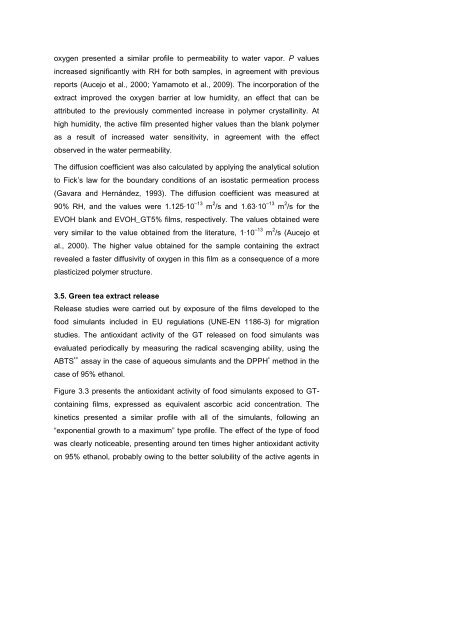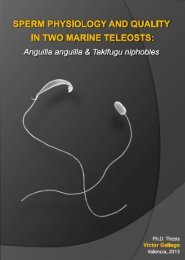Desarrollo y caracterización de polímeros activos ... - RiuNet
Desarrollo y caracterización de polímeros activos ... - RiuNet
Desarrollo y caracterización de polímeros activos ... - RiuNet
Create successful ePaper yourself
Turn your PDF publications into a flip-book with our unique Google optimized e-Paper software.
oxygen presented a similar profile to permeability to water vapor. P values<br />
increased significantly with RH for both samples, in agreement with previous<br />
reports (Aucejo et al., 2000; Yamamoto et al., 2009). The incorporation of the<br />
extract improved the oxygen barrier at low humidity, an effect that can be<br />
attributed to the previously commented increase in polymer crystallinity. At<br />
high humidity, the active film presented higher values than the blank polymer<br />
as a result of increased water sensitivity, in agreement with the effect<br />
observed in the water permeability.<br />
The diffusion coefficient was also calculated by applying the analytical solution<br />
to Fick’s law for the boundary conditions of an isostatic permeation process<br />
(Gavara and Hernán<strong>de</strong>z, 1993). The diffusion coefficient was measured at<br />
90% RH, and the values were 1.125·10 –13 m 2 /s and 1.63·10 –13 m 2 /s for the<br />
EVOH blank and EVOH_GT5% films, respectively. The values obtained were<br />
very similar to the value obtained from the literature, 1·10 –13 m 2 /s (Aucejo et<br />
al., 2000). The higher value obtained for the sample containing the extract<br />
revealed a faster diffusivity of oxygen in this film as a consequence of a more<br />
plasticized polymer structure.<br />
3.5. Green tea extract release<br />
Release studies were carried out by exposure of the films <strong>de</strong>veloped to the<br />
food simulants inclu<strong>de</strong>d in EU regulations (UNE-EN 1186-3) for migration<br />
studies. The antioxidant activity of the GT released on food simulants was<br />
evaluated periodically by measuring the radical scavenging ability, using the<br />
ABTS •+ assay in the case of aqueous simulants and the DPPH • method in the<br />
case of 95% ethanol.<br />
Figure 3.3 presents the antioxidant activity of food simulants exposed to GTcontaining<br />
films, expressed as equivalent ascorbic acid concentration. The<br />
kinetics presented a similar profile with all of the simulants, following an<br />
“exponential growth to a maximum” type profile. The effect of the type of food<br />
was clearly noticeable, presenting around ten times higher antioxidant activity<br />
on 95% ethanol, probably owing to the better solubility of the active agents in

















